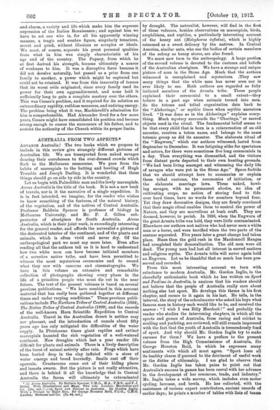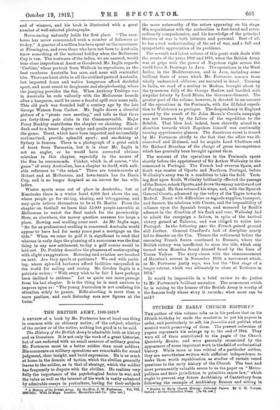AUSTRALIA FROM TWO ASPECTS.* ADVANCE Australia! The two books which
we propose to include in this review give strangely different pictures of Australian life. We are transported from naked savages dancing their corroborees to the over-dressed crowds which flock to the Melbourne racecourse. We pass from the habits of marsupials to the batting and bowling of Hugh Trumble and Joseph Darling. It is wonderful that these things should go on side by side in the country.
Let us begin with Palmolithic man and the lowly marsupials. Across Australia is the title of the book. It is not a new book of travels, nor is it the narrative of a single expedition. It is in fact intended, we imagine, for the reader who wishes to know something of the features, of the natural history, of the vegetation, and of the natives of Central Australia. Professor Baldwin Spencer is professor of biology in Melbourne University, and Mr. F. J. Gillen snb- protector of aborigines for South Australia. Across Australia, which is their joint work, is exceedingly interesting for the general reader, and affords the naturalist a picture of the desiccated interior of the continent, and of the plants and animals, which is often vivid and never dry. Of the anthropological part we must say more later. Even after reading all that the authors tell us it is hard to understand how two white men can have become initiated members of a secretive native tribe, and have been permitted to witness the most mysterious ceremonies and to record what they saw with cameras and cinematographs. We have in this volume an extensive and remarkable collection of photographs showing every phase in the life of a primitive people who must die out in the near future. The text of the present volumes is based on several previous publications. " We have combined in this account material that has really been gathered together at different times and under varying conditions." These previous publi- cations include The Northern Tribes of Central Australia (1894), The Native Tribes of Central Australia (1899), and the records of the well-known Horn Scientific Expedition to Central Australia. Travel in the Australian desert is neither easy nor pleasant, and the introduction of camels about fifty years ago has only mitigated the difficulties of the water supply. In Pleistocene times giant reptiles and extinct marsupials haunted the rich vegetation of a well-watered continent. Now droughts which last a year render life difficult for plants and animals. There is a lively description of the burst of animal aotivity after rain. Frogs which have been buried deep in the clay inflated with a store of water emerge and breed hurriedly. Snails cast off their opercula. Crustaceans come out of their hiding places and insects swarm. But the picture is not really attractive, and there is behind it all the knowledge that in Central Australia the fauna will ultimately be exterminated (1) Across Australia. By Baldwin Spencer, C.M.G., P.R.S., Snd F. J
Gillen. With illustrations and Maps. Two vols. London : Macmillan and Go. [210. net.]—(21 Sport and PCLItilli41 in Australia. By Gordon Inglis. With a Preface by Bight Hon. Sir George Houston Reid, P.C.G., C.N.G. London: Methuen and Co. [7s. Ad. net.]
by drought. The naturalist, however, will find in the first of these volumes, besides observations on marsupials, birds, amphibians, and reptiles, a particularly interesting account of the honey ant (3felephorus inflates), which is highly esteemed as a sweet delicacy by the natives. In Central America, similar ants, who use the bodies of certain members of the colony as honey stores, are also found.
We must now turn to the anthropology. A large portion of the second volume is devoted to the customs and beliefs of the Australian aborigines. We have a strange and unique picture of man in the Stone Age. Much that the authors witnessed is unexplained and mysterious. .They saw many things that the white man has never seen nor is ever likely to see. Both authors are regarded as fully initiated members of the Arunta tribe. These people explained their ceremonial to a small extent—they believe in a past age when animals turned into men. So the totems and tribal organization date back to the " Alcheringa," or mythic times when mythic) ancestors lived. "It was done so in the Alcheringa" explains every- thing. Much mystery surrounds the " Ohuringa," or sacred objects used in the ritual. The fundamental belief seems to be that every child that is born is a reincarnation of an old ancestor, receives a totem name, and belongs to the same totemic group as did its ancestor. The elaborate ritual of the " Engwura," which our authors witnessed, lasted from September to December. It was fatiguing alike for spectators and actors, for there were sometimes five long ceremonials in a day. Then everything was dismantled, and the visitors from distant parts departed to their own hunting grounds. " We had been living amongst and witnessing the daily life of savages who were yet in the Stone Age." Space forbids that we should attempt here to summarize or explain these tribal customs, the ceremonies of initiation, or the elaborate marriage laws. These naked, howl- ing savages, with no permanent abodes, no idea of cultivating crops, no notion of storing food to tide over hard times, have no words for numbers beyond four, Yet they draw decorative designs, they are firmly convinced that their magic ritual enables them to control the power of Nature, and they are marvellous at bush craft. They are doomed, however, to perish. In 1896, when the Engwura of the great Arunta tribe was held, they were little contaminated. Elsewhere our authors met natives who had never seen a white man or a horse, and were terrified when the two parts of the centaur separated. Five years later a great change had taken place. Since then the gold rush in the Macdonnell Ranges had completed their demoralization. The old men were all dead. The young men had lost all interest in sacred matters and religious myths. The Arunta tribe will never again hold an Engwura. Let us be thankful that so much has been pre- served and recorded.
From this most interesting account we turn with reluctance to modern Australia. Mr. Gordon Inglis, in the cheerfully enthusiastic book which he has written on $port and Pastime in Australia, is anxious that his readers should not believe that the people of Australia really care about nothing else but sport. He develops this theme in his first chapter, and recurs to it again in his last. He tells, in the interval, the story of the schoolmaster who asked his boys what famous man in history each would like to be, and received the answer : " I wish I was Billy Murdoch ! " and probably the reader who studies the intervening chapters, in which all the sports and games of Australia, from racing and cricket to sculling and yachting, are reviewed, will still remain impressed with the fact that the youth of Australia is tremendously fond of sport. And why should Mr, Gordon Inglis try to make excuses for them f We have a preface to the present volume from the High Commissioner of Australia, Sir George Houston Reid, in which be expresses many sentiments with which all must agree. " Sport loses all its healthy charm if pursued to the detriment of useful work or the duties of citizenship. I am glad to observe that Mr. Gordon Inglis has taken pains to point out that Australia's success in games has been coeval with her advance in the development of her resources, trade, and industry." Mr. Inglis takes a wide survey, which includes even motor cycling, lacrosse, and bowls. He has collected, with the assistance of various expert contributors, ancient records of earlier days; he prints a number of tables with lists pf tearna
and of winners, and his book is illustrated with a great number of well-selected photographs.
Horse-racing naturally holds the first place. " The race- horse has never commanded such a number of followers as to-day." A quarter of a million has been spent on the racecourse at Flemington, and even those who have not been to Australia know something of the national holiday when the Melbourne Cup is run. The costumes of the ladies, we are assured, would bear close inspection at Ascot or Goodwood. Mr. Inglis regards
Carbine,' whose portrait from Welbeck he reproduces, as the best racehorse Australia has seen, and none will contradict him. There are hunt clubs in all the civilized parts of Australia, but imported foxes and native kangaroos afford doubtful sport, and most resort to draghunts and steeplechasing, where the jumping provides the fun. When Anthony Trollope was in Australia he rode valiantly with the Melbourne hounds after a kangaroo, until he came a fearful spill over some rails. This old pack was founded half a century ago by the late George Watson from Carlow. Mr. Inglis draws a cheerful picture of a "picnic race meeting," and tells us that there are forty-three polo clubs in the Commonwealth. Major Percy Buckley contributes the chapter on shooting. Black- duck and to a lesser degree snipe and quails provide most of the game. Trout, which have been imported and successfully acclimatized, provide splendid sport; and sea-fishing at Sydney is famous. There is a photograph of a great catch of trout from Tasmania, but it is clear Mr. Inglis is not an angler, or he would have corrected obvious mistakes in this chapter, especially in the names of the flies he recommends. Cricket, which is, of course, " the game" of every Australian, has a chapter to itself, with suit- able reference to "the ashes." There are tennis-courts at Hobart and at Melbourne, and lawn-tennis has its Davis Cup, and is no longer despised as an excuse for tea with ladies.
Winter sports seem out of place in Australia ; but at Kosciusko there is a winter hotel 6,000 feet above the sea, where people go for ski-ing, skating, and tobogganing, and may quite believe themselves to be at St. Moritz. From the chapter on football we learn that 55,000 people assemble at Melbourne to watch the final match for the premiership. Here, as elsewhere, the money question assumes too large a place. Rowing and sculling come next. As Mr. Inglis says, " So far as professional sculling is concerned Australia would appear to have had for many years past a mortgage on the title." When we come to golf it is significant to read that whereas in early days the planning of a racecourse was the first thing in any new settlement, to-day a golf course would be laid out. Dr. Pochley describes the pleasures of motor-cycling with slight exaggeration. Motoring and aviation are touched on next. Are they sports or pastimes ? We end with yacht- ing, where splendid harbours afford facilities unequalled in the world for sailing and racing. Mr. Gordon Inglis is a patriotic writer : " With every wish to be fair I have perhaps been inclined to enthuse." Let us quote one more passage from his last chapter. It is the thing he is most anxious to impress upon us : " The young Australian is not confining his attention solely to games. Rifle-shooting is more than a mere pastime, and each Saturday sees new figures at the butts."















































 Previous page
Previous page